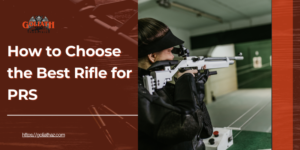Selecting the right firearm can be challenging, especially for newcomers. Whether your interest lies in self-defense, hunting, sport shooting, or collecting, choosing a firearm involves understanding key factors. This guide will help you make an informed and responsible choice.
1. Define the Purpose of the Firearm
The primary purpose of the firearm is the first and most crucial consideration. This will largely determine which type and model best suit your needs.
- Self-Defense: For personal protection, most choose a handgun due to its portability and concealability. Look for firearms that are reliable, easy to handle, and have sufficient stopping power. Features like manageable recoil, simplicity in operation, and size (for concealed carry) are essential.
- Hunting: The species you’re hunting and the environment influence your choice. For instance, small game often requires smaller calibers or gauges, while big game hunting requires larger calibers with significant stopping power. Shotguns are common for bird hunting, while rifles are typical for deer and other big game.
- Sport Shooting: Target shooting or competitive shooting emphasizes precision, comfort, and versatility. Rifles, handguns, and shotguns can all serve this purpose, with calibers varying based on the sport or competition type.
- Collecting: Collectors often seek firearms with historical, rare, or aesthetic value. Factors such as manufacturing date, rarity, and craftsmanship are typically prioritized over functionality.
2. Understand the Types of Firearms
Understanding the right firearm categories helps in selecting the type that fits your intended use.
- Handguns: Compact and portable, handguns are ideal for self-defense. They are generally divided into two categories:
- Revolvers: Known for simplicity and reliability, revolvers have a lower capacity (usually 5-6 rounds) and are easy to operate, making them a great option for beginners.
- Semi-Automatics: These offer higher capacity and quicker reloading but require more maintenance and training due to additional complexity.
- Rifles: Known for range and precision, rifles are suitable for hunting, target shooting, and sport. They come in various actions, such as:
- Bolt-Action: A reliable, precise choice, especially for hunting and long-range shooting.
- Lever-Action: Known for a smooth firing mechanism, it is popular in hunting and sport shooting.
- Semi-Automatic: Offers faster follow-up shots, suitable for both sport shooting and some hunting applications.
- Shotguns: Known for versatility, shotguns are effective for hunting, sport shooting (like clay shooting), and home defense. Common types include:
- Pump-Action: Durable and reliable, these require manually pumping the action to reload.
- Semi-Automatic: Faster follow-up shots, commonly used in sport and hunting.
- Break-Action: Typically seen in double-barrel or single-barrel shotguns, easy to operate and often used in sport.
If you’re unsure which type is the right firearm for you, visiting a gun store in USA can provide hands-on experience and advice from knowledgeable staff, helping you make an informed choice.
3. Caliber and Ammunition for the Right Firearm
Caliber (or gauge in shotguns) refers to the firearm’s internal barrel diameter and directly influences power, recoil, and intended use.
- Handguns: Common calibers include:
- .22 LR: Low recoil, economical, and suitable for beginners.
- 9mm: Popular for self-defense due to manageable recoil and effective stopping power.
- .45 ACP and .357 Magnum: More stopping power but higher recoil; preferred by experienced users.
- Rifles: Calibers vary widely based on use:
- .22 LR: Suitable for target practice and small game.
- .308 Winchester or .30-06 Springfield: Common choices for big game hunting.
- 5.56/.223: Used for sport shooting and varmint hunting.
- Shotguns: Gauge affects versatility:
- 12-Gauge: Known for versatility in hunting and home defense.
- 20-Gauge: Lighter recoil, making it suitable for smaller game or younger shooters.
4. Ergonomics and Fit
Comfort and handling are key in ensuring control, accuracy, and enjoyment when using a firearm.
- Grip: Should fit your hand comfortably for a secure hold, reducing hand fatigue during use.
- Weight and Balance: The firearm’s weight should feel manageable, and the balance should allow for smooth handling.
- Length of Pull: For long guns, this distance from the trigger to the butt of the stock should match your body size and shooting posture to maintain comfort and control.
5. Safety Features
Safety is crucial in any firearm. Look for features that enhance control and minimize accidental discharge.
- Manual Safeties: Mechanical locks that prevent the firearm from firing until disengaged, providing an extra layer of security.
- Trigger Safeties: Often integrated into the trigger, this feature prevents the firearm from discharging unless the trigger is deliberately pulled.
- Drop Safeties: Prevent accidental discharge if the firearm is dropped, enhancing safety for concealed carry and home storage.
If your firearm purchase is for personal defense, remember that many states require concealed carry permits to legally carry a concealed handgun in public. Check local regulations for specific requirements.
6. Training and Practice
Purchasing a firearm is only the beginning; consistent practice is essential for safe and proficient use. Enroll in firearm training courses to develop skills in handling, aiming, cleaning, and maintenance. Consider a reputable range for ongoing practice, especially if you’re new to firearms or switching to a different type.
7. Legal Considerations
Laws on firearm ownership and carry vary by country, state, and local jurisdiction. Before purchasing, research and adhere to regulations regarding permits, background checks, waiting periods, and any registration requirements. Also, understand any restrictions on specific firearms or features in your area, such as magazine capacity limits.
Conclusion
Selecting the right firearm is a highly personal choice that depends on your unique requirements and preferences. By assessing your purpose, understanding firearm types, selecting the appropriate caliber, evaluating ergonomics, prioritizing safety, and following legal guidelines, you can make a well-informed decision. Remember, responsible ownership and continued practice are fundamental for safe and skilled firearm handling.




